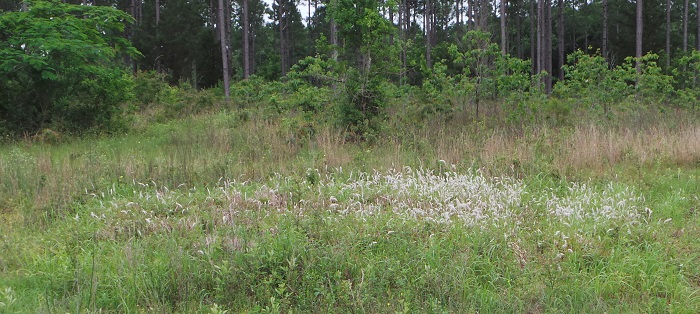Six Rivers “Dirty Dozen” Invasive Species
Cogongrass (Imperata cylindrica)
Define Invasive Species: must have all of the following –
- Is non-native to the area, in our case northwest Florida
- Introduced by humans, whether intentional or accidental
- Causing either an environmental or economic problem, possibly both
Define “Dirty Dozen” Species:
These are species that are well established within the CISMA and are considered, by members of the CISMA, to be one of the top 12 worst problems in our area.
Native Range:
Cogongrass is from southeast Asia.
Introduction:
It was accidentally introduced as an “escapee” from satsuma crates brought to Grand Bay, Alabama in 1912. It was later intentionally introduced into Mississippi in the 1920s as a forage crop and then to Florida in the 1930s for both forage and soil stabilization.
EDDMapS currently list 79,134 records of this plant. All are listed in the southeastern U.S. Most are in Florida and Alabama, but there are records from Mississippi, Louisiana, Texas, Georgia, North and South Carolina.
Within our CISMA there are 13,279 records. This is probably underreported.
Description:
Cogongrass is a perennial grass that can vary in color from a bright-light green when young to a brown-orange when older. It does die back in areas with cold winters and heavy frost and becomes brown. The leaves emerge from the ground in clumps and can reach four feet in height. The blades are 0.5-0.75 inches wide and the light-colored midline is off center. The blades are serrated along the edge. In the spring the grass produces large white colored fluffs of seeds extending above the leaves to be carried by the wind. There are numerous small seeds joined on long hairs of these structures. There is an extensive rhizome system beneath the ground that can contribute to short distance spread.
Issues and Impacts:
The plant spreads aggressively and has been found in ditches, along roadsides, in pastures, timberlands, golf courses, empty lots, and even on barrier islands. It spreads both by seed wind dispersal and rhizome fragmentation. The plant is known to be allelopathic, desiccating neighboring plants and moving in. It can form dense monocultures in many areas.
The serrated edges of the leaves make it undesirable as a livestock forage, a fact not detected until the plant was established. It can cover large areas of pasture making it unusable. In the winter the plant becomes brown and can burn very hot. Timberland that has been infested with cogongrass can burn too hot during prescribed burns actually killing the trees.
It is currently listed as one of the most invasive plants in the United States. It is a federal and state noxious weed, it is prohibited all across Florida and has a high invasion risk.
Management:
The key to controlling this plant is destroying the extensive rhizome system. Simple disking has been shown to be effective if you dig during the dry season, when the rhizomes can dry out, and if you disk deep enough to get all of the rhizomes. Though the rhizomes can be found as deep as four feet, most are within six inches and at least a six-inch disking is recommended.
Chemical treatments have had some success. Prometon (Pramitol), tebuthurion (Spike), and imazapyr have all had some success along roadsides and in ditches. However, the strength of these chemicals will impede new growth, or plantings of new plants, for up to six months. This can lead to erosion issues that are undesirable. Glyphosate has been somewhat successful, and its short soil life will allow the planting of new plants immediately. Due to this however, it may take multiple treatments over multiple years to keep cogongrass under control and it will kill other plants if sprayed during treatment.
Most recommend a mixture of burning, disking, and chemical treatment. Disking and burning should be conducted in the summer to remove thatch and all older and dead cogongrass. As new shoots emerge in late summer and early fall herbicides can then be used to kill the young plants. Studies and practice have found complete eradication is difficult. It is also recommended not to attempt any management while in seed (in spring). Tractors, mowers, etc. can collect the seeds and, when the mowers are moved to new locations, spread the problem. If all mowing/disking equipment can be cleaned after treatment – this is highly recommended.
For more information on this Dirty Dozen species, contact your local extension office.
References
Cogongrass, University of Florida IFAS Center for Aquatic and Invasive Plants
https://plants-archive.ifas.ufl.edu/plant-directory/imperata-cylindrica/
Imperata cylindrica. University of Florida IFAS Assessment.
https://assessment.ifas.ufl.edu/assessments/imperata-cylindrica/.
Early Detection and Distribution Mapping System (EDDMapS)
Six Rivers CISMA
https://www.floridainvasives.org/sixrivers/
- Our Environment: Part 11 – We Need Water - July 7, 2025
- Our Environment: Part 10 – Improving Agriculture - June 20, 2025
- Marine Creatures of the Northern Gulf – Snails and Slugs - June 20, 2025

